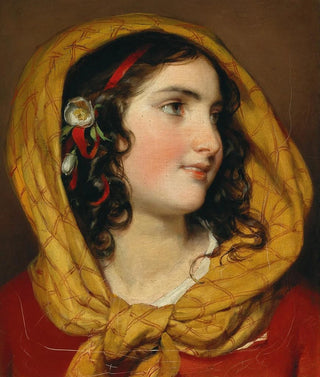Art print | Portrait of a girl with a red headband and a yellow scarf - Friedrich von Amerling


View from behind

Frame (optional)
In the delicate universe of 19th-century art, the portrait of the young girl by Friedrich von Amerling emerges as an iconic work, revealing not only the artist's technical mastery but also a sensitivity that transcends time. The art print Portrait of a girl with a red headband and a yellow scarf - Friedrich von Amerling invites us to immerse ourselves in a frozen moment, where beauty and innocence combine with rare elegance. This painting, both simple and complex, evokes an atmosphere of softness and mystery, captivating the gaze while awakening the imagination.
Style and uniqueness of the work
Friedrich von Amerling's style is characterized by meticulous attention to detail, mastery of colors, and a capacity to capture the very essence of his subjects. In this portrait, the young girl, adorned with a red headband and a yellow scarf, embodies natural grace. The vivid colors and delicate textures of the fabric contrast with the softness of her face, accentuating her sparkling gaze. Every brushstroke seems to have been chosen with care, creating a visual harmony that attracts and holds attention. The subtly orchestrated light plays on the child's features, revealing an emotional depth that goes beyond a simple representation. This painting, while a portrait, also becomes a window into the soul of the young girl, offering an introspection on youth and ephemeral beauty.
The artist and his influence
Friedrich von Amerling, born in 1803 in Vienna, is an artist whose work has profoundly marked the Austrian artistic landscape. Trained in the traditions of neoclassicism and influenced by romanticism, Amerling managed to combine these currents to create a unique style that is his own. His ability to depict portraits with such liveliness and emotion made him one of the most sought-after portraitists of his time. Through his works, he not only captured the appearance of his subjects but also their essence, their personality. His influence endures today, inspiring many contemporary artists who seek to explore the relationship between

Matte finish

View from behind

Frame (optional)
In the delicate universe of 19th-century art, the portrait of the young girl by Friedrich von Amerling emerges as an iconic work, revealing not only the artist's technical mastery but also a sensitivity that transcends time. The art print Portrait of a girl with a red headband and a yellow scarf - Friedrich von Amerling invites us to immerse ourselves in a frozen moment, where beauty and innocence combine with rare elegance. This painting, both simple and complex, evokes an atmosphere of softness and mystery, captivating the gaze while awakening the imagination.
Style and uniqueness of the work
Friedrich von Amerling's style is characterized by meticulous attention to detail, mastery of colors, and a capacity to capture the very essence of his subjects. In this portrait, the young girl, adorned with a red headband and a yellow scarf, embodies natural grace. The vivid colors and delicate textures of the fabric contrast with the softness of her face, accentuating her sparkling gaze. Every brushstroke seems to have been chosen with care, creating a visual harmony that attracts and holds attention. The subtly orchestrated light plays on the child's features, revealing an emotional depth that goes beyond a simple representation. This painting, while a portrait, also becomes a window into the soul of the young girl, offering an introspection on youth and ephemeral beauty.
The artist and his influence
Friedrich von Amerling, born in 1803 in Vienna, is an artist whose work has profoundly marked the Austrian artistic landscape. Trained in the traditions of neoclassicism and influenced by romanticism, Amerling managed to combine these currents to create a unique style that is his own. His ability to depict portraits with such liveliness and emotion made him one of the most sought-after portraitists of his time. Through his works, he not only captured the appearance of his subjects but also their essence, their personality. His influence endures today, inspiring many contemporary artists who seek to explore the relationship between






